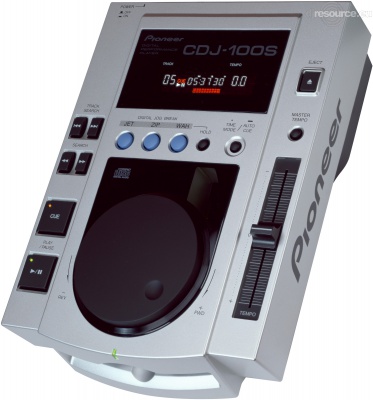Pioneer CDJ-100s Performance CD Player with Effects
Submitted by LeadThis content is © 2003-2025 The DJResource
Pioneer DJ - Player Tabletop Overview
Gearbase product details : Pioneer DJ CDJ-100S
Pro Performance
The Pioneer CDJ-100s is a CD player originally designed for home use in the Performance series products, while the CDJ-500s is the professional top-end model. After some while the CDJ-100 was not only used by the home-dj but also by lots of rental companies and club installations. The CDJ-100 was the first reliable CD player that had a very robust anti shock system due to oil filled shock mounts for the drive assy.
Specifications
Slot In CD
The new disc loading slot mechanism makes it fast and easy to play, change and remove discs from the player. Discs are inserted directly without the need to open doors or trays, making operation and track selection that much faster.
The green LED in the top middle of the slot-in is a nice target spot to aim for when inserting a CD in a dark location.
Oil-Damped Suspended Drive Assy
One of the strengths of the CDJ-100s is it's skip resistance, it will perform flawless in situation normal CD players would skip. This is partly to an Oil-damped floating suspension system that holds the Drive Assy and protects it against vibrations and impacts.
This oil-damped floating suspension prevents sound skipping even when the unit is subjected to impacts during use or floor- transmitted vibrations.
Sensitive Jog Dial
The large-diameter (100mm) jog dial allows the user to manipulate the music in a way common to analogue turntables. Merely rotating the dial with the fingertips allows you to find the precise entry point for tracks, moving in increments of one-frame (1/75th second).
3 Digital Jog Break Effects
Once activated the parameter of this effect can be changed (when it is activated) by rotating the Jogwheel.
Activated any of the three effects (JET, ZIP, WAH) on the CDJ-100 by pressing the appropriate blue button above the Jogwheel. After this you can alter the parameter of the effect with the Jog Wheel, this effect can be maintained by pressing the HOLD button.
To get the effect parameter back to 0 again, just press the HOLD button again and the parameter will slowly return to the zero position.
2022 edit: Years later Pioneer will add such effects to their mixers and call them Sound Color FX.
Two Tempo Control Ranges
Achieving the desired tempo adjustment has been facilitated by providing two variable ranges: either ±10% (0.1% steps), or +10 to -16% (in 0.2% steps).

Digital Output Digital Output
 USA Only
USA Only : The CDJ-100s sold in the American market is slightly different than the model that is being produced for the European market. The CDJ-100s is one of the very few models that have different specification depending the region the product is designed for.
: The CDJ-100s sold in the American market is slightly different than the model that is being produced for the European market. The CDJ-100s is one of the very few models that have different specification depending the region the product is designed for.
The American model has a digital output on the backside, this feature is missing on the European version. Activating the digital output disables most of the DJ related features.
Pioneer Standard Features
Cue
You make a Cue point on any CDJ by putting the deck in Pause mode and pressing the Cue button. There will be an orange illumination in the button indicating a Cue point is in memory.
When the deck is put in Pause mode there will be a stuttering sound, this starts at the set cue position so the point can be accurately set.
Cue Point Sampler Function
Allows playing up to ten minutes of sound from a preselected cue point. This function is convenient for confirming a cue point or creating a track sampler.
One a Cue point is set (orange illumination) you can press the Cue button when the deck is in Play mode to start playback from the Cue position as long as you hold the button (max 10 minutes).
Auto Cue Function
Automatically set a Cue point once a track is loaded at the desired audio level, 0dB is loudest, -78dB the quietest.
This function also forces the CDJ to pause playback when a track is loaded. The Auto Cue point can be used for Cue Point Sampler playback.
Master Tempo
Changes music tempo without changing pitch. With analogue systems, changing track speed results in a change in pitch. Master Tempo Control takes advantage of the unique features of digital medium enabling track speed to be changed with no deterioration of the original pitch.
Displays Playing Address
An analogue bar graph gives direct indication of elapsed and remaining playing time. This bar graph provides a direct visual readout of the progress of the track playback, comparable to the moving needle position on an analogue record.
The length of the bar gives the user immediate knowledge of the current location on the track and the flashing bar display warns that the track is coming to an end.
Quick Start
Pressing the play button from the standby mode produces instantaneous (0.01 second or less) music start. Normal CD players require up to 0.3 seconds from the standby mode to the production of sound. The quick start function virtually eliminates this time for immediate response of the deck on the DJs press of the button.
Fader Start/Fader Back Cue Play
When the CDJ-100S is used with the DJM-500 or DJM-300 mixer, you can start the music by increasing the Channel Fader (or sliding the Cross Fader). Closing the Fader will return the CDJ-100s to the designated cue point.
Relay Play
Connecting two CDJ100S decks with the faderstart cable in the Control terminal on the rearside.
If two units are connected, when playback of a track comes to an end on one deck, standby mode on the second deck is released instantly beginning playback on that deck. A CUE Point is necessary to get the Auto relay Play working.
What do you think about Pioneer CDJ-100s ??
Gearbase
Related Blog Posts
Please consider making this website possible by disabling your Ad Blocker.
Or become a Gold Member, they don't see ads.
There are 11 Comments
 bij het openen van de speler zie ik namelijk niet onmiddellijk de mogelijkheid om die laser bloot te leggen.
bij het openen van de speler zie ik namelijk niet onmiddellijk de mogelijkheid om die laser bloot te leggen.dank voor eventuele respons!
ArCeewrote on 06-02-2007 16:35:
Zijn complete schoonmaaksets in de handel. Daar zit een cd met borsteltjes bij en een schoonmaak vloeistof. Even in je speler laten draaien en je lasar is weer schoon.
cdtjes met borsteltjes moet je niet gebruiken!!! is nog slechter voor je laser!
gewoon meet een wattenstaafje gedrenkt in (laser)alcohol en daarmee voorzichtig over je laser gaan.


Maar inderdaar je moet er wel ff een doek omheen leggen wil je hem stofvrij houden

Please consider making this website possible by disabling your Ad Blocker.
Or become a Gold Member, they don't see ads.
Some parts of this website require you to login. Using an account on DJResource has a lot of advantages such as:
Adding Content, getting Notifications, Like content, Downloading and Uploading Images and much more.
Create your account to get involved with the Community
Most visitors online this month : 897
Lifetime Pageviews since 2003 : 242.826.524



